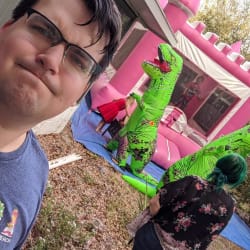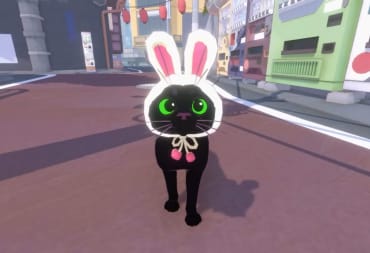Dungeons & Dragons has taken many forms over the years from the literal Actual Plays that bring the game to a streamed audience, or in the abstract as video games and movie adaptations. The Twenty-Sided Tavern brings Dungeons & Dragons to an audience in a whole new way with an interactive stage show experience where no two showings are the same.
This week I had a chance to sit down with Dungeon Master, David Andrew Greener Law (DAGL), and Tavern Keeper, Sarah Davis Reynolds, about what went into the creation of such a show, how they involve the audience in the show, and why this isn't a show you'll want to miss when it opens at Stage 42 in New York City next week. Previews start April 19th and the official opening is on May 5th.
What is The Twenty-Sided Tavern?

DAGL began our conversation by explaining that The Twenty-Sided Tavern isn't just an event, but also "a place where we gather to tell stories where the Audience is basically the fourth player [...] who decides ultimately how this is going to play out."
The Audience get to participate in The Twenty-Sided Tavern not only by making decisions for the party but also by taking part in a variety of digital games via their phone, as well as physical games where they can be called up onto the stage.
"Playing D&D with 500 of your closest friends," is how Reynolds succinctly described it "Except combat won't take that long, don't worry."
Coming from a theater background DAGL, Reynolds, and their third partner David Carpenter were all working together on creating interactive theater experiences during the pandemic. All being fans of Dungeons & Dragons there was a moment where they thought "Well, we all like Dungeons & Dragons and we like what we're doing here, what if we put the two together?"

A New Way To Play and Interact With Dungeons & Dragons
"It is that idea of telling a story together, it's so collaborative. The point of Dungeons and Dragons is that everyone has a voice at the table. We really thought this was a way to give the audience a way to also have a voice in a way that they don't have just watching other people play."
DAGL explained that comparing themselves to the many different experiences where you can watch other people play Dungeons & Dragons at Twenty-Sided Tavern they were "interested in discovering and uncovering how [they] could give agency and authenticity to D&D Comedy"
"And consequences!" Reynolds quickly added explaining that "if you yell a really bad NPC name to us we might shame you a little bit." The first roll of the show is also the audience taking a consumable that could be good or bad depending on their roll.
When I asked if that was a threat DAGL and Reynolds laughed and corrected me that "it's only a little bit of one."

Power To The Audience
The digitally powered interactive elements of The Twenty-Sided Tavern run on a system called Gamiotics.
"It is a browser-based technology that you open on your smartphone, you QR code in, and it lets us send you options to choose between, minigames like tapping on a button a lot of times to fill something up, you're solving riddles by typing in the answer. There's a lot of interactivity that we can send to you and that allows us to reach all 500 people in the house as opposed to the five people on stage."
"It also means if you aren't as bold and don't want to get brought up on stage you get to have a voice, you get to see if we are going down the left path or the right path and you want to go left you can see that little bar go up on screen" Reynolds added, "You immediately see that your voice has an impact."

Making the change to a Stage Show it was also important that there were a lot of simplified mechanics. It was quite proudly explained that combat "takes 20 minutes max" and how taking something like Combat and turning it into a simple endeavor was necessary when their show is only 2 hours long.
"It's a lot of balance of saying how do we take mechanics as they exist in 5e and how do we make that interesting to watch"
The Roles of Dungeon Master and Tavern Keeper
Beginning to talk about how the show itself runs I wanted to understand from DAGL how he approached DMing for a stage play differently from how he might DM for a home game or in an Actual Play.
"It really depends on how you play D&D at home," DAGL began, "for me, it's not that different because my at-home games get a bit…"
"Rowdy?" Reynolds cut in
"I love that antagonism between players and DMs that arise when players ask 'Can I do this?' or 'How can I push this boundary?' and then the DM needs to figure out the way to allow that. [...] I like to go a long way so I'll organize fun and interactive puzzles at home or clues that lead you around the house. [...] At the end of the day the show we're making is a comedy, it doesn't mean we don't have stakes or pathos it is a lot of fun"

Reynolds added again "You do have more funny wigs here" explaining that each wig represents a different NPC that the party may come across on their journey.
In sharing what he's learned in The Twenty-Sided Tavern that he brings to his home game DAGL explained that it's the ability to pivot. "The campaign has milestones, we know we're going from A to B to C and it's a matter of how we get there. The number of times I'm surprised with how we get there grows every day."
"Some of our best surprises have come from the audience"
While the role of Dungeon Master is one that a fan of D&D or Tabletop Role-Playing games would be familiar with I wanted to learn more from Reynolds about what the role of Tavern Keeper was that she was playing.
"It's almost like a game show, it's helpful to have a duo." Explaining their roles Reynolds continues "One who is in charge of the story and one who is more in charge of the game. It allows the DM to be playfully antagonistic where the Taven Keeper can come in and say 'no, the DC is still 15, giving me puppy dog eyes is not going to change that"
As Tavern Keeper Reynolds thinks of herself as the referee but also as a conduit for the audience voice as she's the one running the technology on the stage. "Essentially the tavern keeper knows the Toybox, they have all of the toys that anyone could possibly play with and they know how to best use them."

An example anecdote that was shared would be when the DM wants to keep a part of the audience engaged and would ask the Tavern Keeper for a recommendation of a game to be played.
"The Tavern Keeper herding the cats that are the players, and the Dungeon Master herding the cats that are the audience"
The Adventure Begins
While there's only a two-hour run-time The Twenty-Sided Tavern picks up with onboarding. While many of the fans are D&D fans they always want to make sure that everyone understands the mechanics behind the show.
"Onboarding is really exciting because it puts everyone on the same level. Whether you've played D&D before or not there are still things they'll need to learn about the way that we do it. Everything from the basics of 'Here's what a Nat 20 means, here's what a Nat 1 means' all the way to 'Here are the traditions we have and how you interact'"
"After onboarding [the audience chooses] characters that are going to go on the journey and then the journey itself begins"
They didn't reveal much about the plot other than "there's corruption in the weave" and that it was very high stakes.

Building a Party
The main cast is comprised of actors such as Tyler Nowell Felix (“Modern Family”) as Fighter, Madelyn Murphy (The Twenty-Sided Tavern) as Mage, and Diego F. Salinas (Drunk Shakespeare) as Rogue among others.
At the start of each showing it was explained that each actor would have a few characters they know how to play. "The Fighter might know a Barbarian, Paladin, or Monk and at the beginning of every show the audience will vote on who they want to see."
From there the Audience will be the worm in the head of each character where they'll direct the players in things like combat.

The Structure of The Twenty-Sided Tavern
Hearing how permutations immediately begin from onboarding to the character and party creation I then delved into how the adventure was also built in permutations. "We know we're going from A to B to X is helpful, but the reality is we know we're building six shows every time we make one."
"It's statistically and mathematically impossible that we are ever going to see the same story twice" DAGL explained "It would be very difficult to follow the same path twice as there's so many if-thens and variables. Obviously with the nature of the show and the performers in terms of party composition, it's a completely different experience."
"There are unlockable moments that may ro may not happen based on your show based on how well you're doing, or how poorly you're doing"
DAGL revealed that there was one room in their adventure when they were showing in Chicago that they never ended up visiting in their whole 12-week run. The NPC that the party would have run into was a small mouse.
"He was a little carnival mouse and he had little carnival games like a big hammer" Reynolds explained
The Twenty-Sided Tavern of the Future
I asked if there were any elements from prior campaigns that they brought forward to new campaigns, or even if there were any ideas that the ability to pull off wasn't realized yet. Reynolds did let us know that they're working on a new campaign currently where "the base mechanics of it [she's] very excited to explore. It's something we've never used before"

"We're also always looking for ways to expand the toolbox. As of right now, as the party continues to grow and gain experience they do so together. While brainstorming we're going 'maybe we can make an asymmetrical experience where one of the cohort levels up but the others don't, how do we completely make the experience as asymmetrical as possible"
Looking to the future they're also looking for ways to incorporate second objectives into each of the characters. The party goal might be to defeat the evil force, but "the fighter knows that they want to do the most damage in combat so the audience is always going to be angling for the choices that mean the fighter gets to do more damage.
Funny Audience Anecdotes from The Twenty-Sided Tavern
To get the best idea of how wild The Twenty-Sided Tavern can be I asked DAGL and Reynolds if there were any particularly memorable anecdotes from previous shows that were particularly funny.
DAGL said the first that came to his mind is during onboarding when an audience member rolled poorly and needed to take a drink of Malört.
For Reynolds, it was "a show in Chicago where there were twins present for their Bar Mitzvah and they were screaming an NPC name at us the whole time. We finally heard it and grabbed it and I said 'That sounds like a real name.' I very quickly googled on-stage and it was the Prime Minister fo Luxembourg. I don't know why these twins were so obsessed with the Prime Minister but they were so this NPC and their entire arc for this show became about politics."
Similarly in terms of NPC getting names that alter their character there was a Southern NPC that was given a very French-sounding name. "That NPC, who has been written to have a southern dialect, ended up using that same vocabulary with a French-sounding dialect. If you've never tried saying 'y'all' with a French accent it's a lot of fun."
As we closed out Reynolds wanted to make sure anyone interested in checking out the show is aware that "there is so much care put into every part of this. We are huge nerds and huge D&D fans and this is made by nerds for nerds really. We're so excited for people to join us and find the easter eggs we have everywhere and come play games and tell stories with us."
Have a tip, or want to point out something we missed? Leave a Comment or e-mail us at tips@techraptor.net













